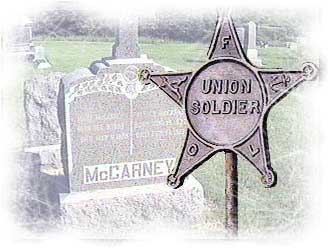James McCarney

On Christmas Eve, 1862 James McCarney enlisted in the Union Army.
He was then 36 years old, not yet a U.S. citizen, and was living in Burnsville, Minnesota with his wife, Margery, and the
five children that had been born to them by that time (Catherine, John, Maggie, Mary
and James).
James enlisted in Company M, 1st Minnesota Mounted Rangers, a volunteer unit organized
by one Captain Starkey. This unit mustered in at Fort Snelling (St. Paul) on December
30, 1862 and was scheduled to be deployed to "the Indian Expedition." However, James seems
never to have seen action for while with this unit at Fort Ridgely, Minnesota, during
the winter/spring of 1862-63, James contracted severe rheumatism in his joints and
total deafness in his right ear due to exposure standing guard watches and ‘leaky’
quarters. On August 19, 1863 and after a period of hospitalization, James received
a Disability Discharge on the order of General Pope, the Commanding General.
At some time in the 1880s James filed for a U.S. Army pensions based on his Civil
War service and his continuing disabilities (he became lamer and deafer with time).
The pension was granted in 1886 and was made retroactive to his date of discharge in 1863.
The disability award was made according to the following schedule:
| 20 Aug 1863 - 14 Aug 1881 |
$2/ month |
| 15 Aug 1881 - 2 Apr 1884 |
$3/ month |
| 3 Apr 1884 - 9 Dec 1886 |
$4/ month |
| 27 Aug 1888 - death |
$16/ month |
Presumably the McCarney family continued to draw upon this pension
until the time of James' death in 1902 at the age of 74. His obituary states that
"he had been ill for a long time with dropsy and considering his advanced age
he was not able to endure the pains and suffering which this dreaded diseasee brought
on..."

Miller Home
NOTES:
Citizenship -- James McCarney was naturalized on October
21, 1873 at Litchfield, Meeker County, MN.
Soux Uprising -- In August 1862, the Santee Sioux of Minnesota
under Chief Little Crow, angered by the failure of the Federal government to provide
annuities and by the poor quality of rations, went on the offensive. They killed
approximately 800 settlers and soldiers, took many prisoners, and caused extensive
property damage throughout the Minnesota River Valley. Fort Ridgely, about twelve
miles from the Lower Sioux Agency, became the refuge for white civilians. The fort's
commander, Capt. John S. March set out with most of his men for the Lower Sioux Agency.
Before reaching the agency, a large Native American force surprised the soldiers,
killed half of them, including Marsh, and pursued the survivors back to the fort.
On August 20th, about 400 Sioux attacked the fort but were repulsed. On the 22nd,
800 Sioux attacked the fort but the garrison and civilians held the fort.
On September 19, 1862, Col. Henry Hastings Sibley set out from Fort Ridgely with
1,500 volunteers to put down the Santee uprising. As they neared Wood Lake on Septernber
23, Sibley’s men escaped an ambush by 700 warriors under Chief Little Crow and engaged
them in a battle. Sibley's force won the day inflicting heavy casualties on the Sioux.
For this action, Sibley received a promotion to brigadier general. Wood Lake was
the first decisive
defeat of the Sioux since the uprising began.
Disability -- File No. 342,524 in the National Archives
contains copies of the Discharge papers, medical certifications, James' statement
and description of his level of disability as well a statement by Margery McGinley
McCarney (in her own hand) listing the nanes and brithdates of all their children
and the circumstances of their wedding in Benton, Wisconsin.

Miller Home

